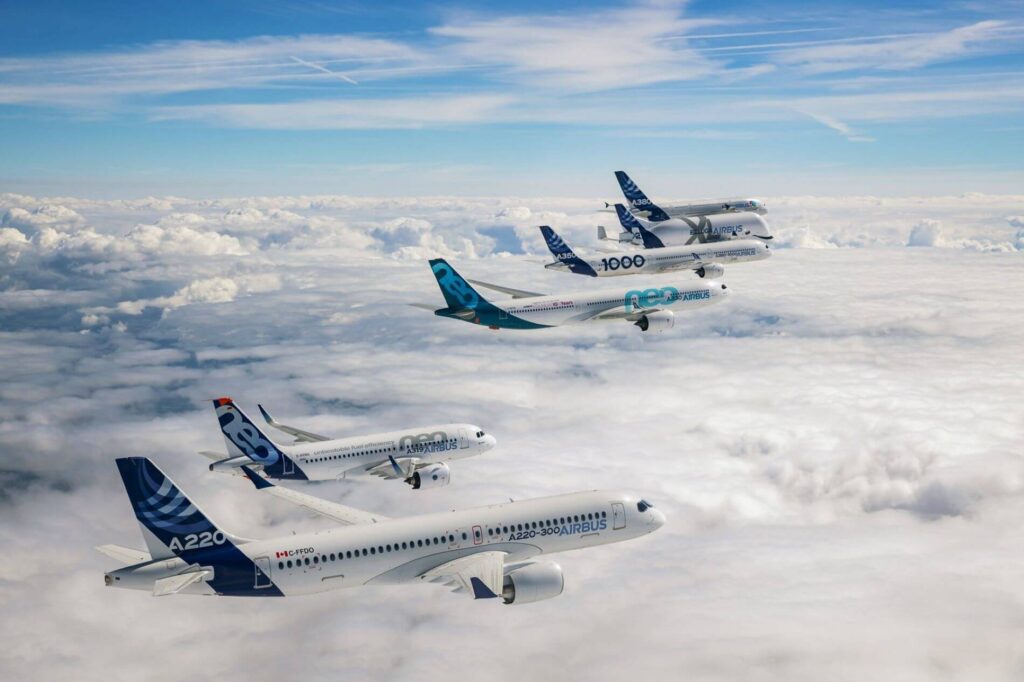It is difficult to say whether Airbus’ lineup of airliners is easier or harder to understand than Boeing’s. On the one hand, there are less models and the production history is not as densely packed with experiments. On the other hand, there are things that seem to defy logic.
Let’s take all the current production models (even the A380, which is in production just formally) and compare their ranges and passenger capacities: arguably the most important metrics, or at least the ones that mostly distinguish aircraft from one another. In the chart below we see the clear distribution: narrow-body aircraft on the left and wide-body ones on the right. But some questions immediately arise.
One of them is regarding the A220 and the A320. Judging by their characteristics, the aircraft seem to be almost identical. The A320 has more variants that encompass the A220 and provide more flexibility, as an airline can choose the exact aircraft it needs for the range and passenger capacity. An explanation of the curiosity is rather simple – the A220 is not really Airbus aircraft. It was originally designed by Bombardier and designated C-Series, but after a number of shenanigans, Airbus overtook the program. Back then, the “neo” versions of the A320 did not exist and the A220 – a brand new and optimized airframe – was a step above anything the A320 could offer. Now, it just adds another layer of flexibility to Airbus narrow-body lineup.
The situation with wide-body twin-aisle aircraft is simpler. There is the A330, mid-sized mid- to long-range airliner similar to the Boeing 787 Dreamliner. Then there is the A350, spank-new, high-tech aircraft for long range and large capacity. And the A380 as well, for those situations when an airline needs to haul reeealy large amounts of people over long distances, and some of those people also want to take a shower mid-flight.
While, in general, all the models and variants constitute a nice line and cover all ranges and capacities rather proportionally, there are a lot of overlaps. It is even more apparent if we display just the passenger capacities of different models, as most of them can have different configurations with more or less seats, depending on the need.
It is… strange. The A220 and the A320, as well as the A330 and the A350 are, essentially, complimenting each other with the same capacities. If we step back and remember a similar diagram from Boeing’s lineup, it constituted a neat ladder, where each aircraft was exactly one step larger than the previous one.
Which shows that Airbus’ philosophy is a bit different. Their models are aimed at different ranges, not capacities, and the flight distance is where we find the ladder. Take a look:
Sure, there is an overlap between the A330, A350 and A380. Also, a gap exists between the A220/A320 and the wide-bodies. Despite that, the situation is much clearer here than in the previous chart.
By the way, regarding that gap. Boeing’s lineup had the same problem, the lack of middle-sized airplanes, which is partially filled by the flexible A330, but not entirely. Yet if we look at the history of Airbus, a ghost of a long-abandoned model arises as well.
The chart below adds capacities and ranges of some recently discontinued Airbus models to the existing ones. As it gets heavily cluttered this way, feel free to click on any model name in the legend to remove its data points.
As we can see, the A310 – the successor of the A300, the aircraft that gave birth to Airbus in the 70s – was right in the middle between narrow- and wide-bodies. It was discontinued in the 2000s for much of the same reasons as the Boeing 757. Some aircraft of the type remain in limited service and talks about its possible return (with new efficient engines) remain.
Oh, and there was the A340 as well. Four-engine airliner born out of necessity to traverse oceans back when ETOPS regulations prevented double-engine aircraft from doing so. It was a deviation from the whole concept of efficient wide-body twinjets Airbus pioneered, swallowed and replaced by the A330 and the A350. It is, most likely, not going to be missed.

